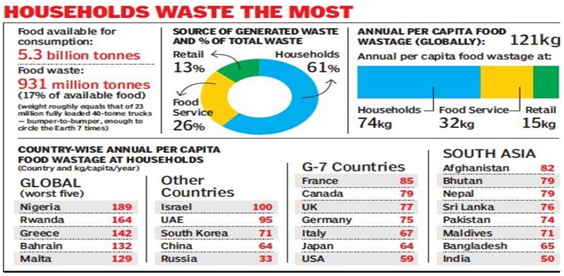

According to the Food Waste Index Report 2021, 17% of all food available at consumer levels was wasted in 2019.
Context
According to the Food Waste Index Report 2021, 17% of all food available at consumer levels was wasted in 2019.
About
The Report
- The report is released by United Nation Environment Programme (UNEP) and partner organisation WRAP.
- The index was prepared by using data from 54 countries and then extrapolated to the remaining countries.
- United Nations Environment Programme (UNEP) revealed that food waste was a global problem and not that of just the developed world.
Key-highlights of the Report
- Around 931 million tonnes of food waste was generated in 2019, sixty-one per cent of which came from households, 26 per cent from food service and 13 per cent from retail.
- 17 per cent of total global food production may be wasted.
- On an average, 74 kilograms of food was wasted per capita at the household level.
- Some countries like Austria and South Africa produce very low amounts of waste at 39 kg per capita per year and 40 kg per capita per year respectively.
- Nigeria and Rwanda are producing waste at 189 kg per capita per year and 164 kg per capita per year respectively.
India’s Ranking-
- In India, the household food waste estimate is 50 kg per capita per year, or 68,760,163 tonnes a year.
- The household food waste estimate in the US is 59 kg per capita per year, or 19,359,951 tonnes a year, while for China these estimates are 64 kg per capita per year or 91,646,213 tonnes a year.

Impact of food waste
Food waste has substantial environmental, social and economic impacts.
- GHG Emissions: 8-10 per cent of global greenhouse gas emissions are associated with food that is not consumed.
- Economic loss: Food loss and waste causes about $940 billion per year in economic losses. Reductions can save money for farmers, companies, and households.

